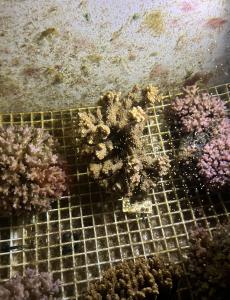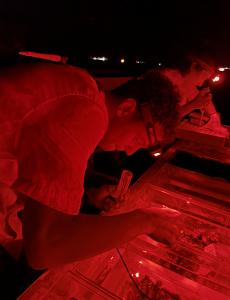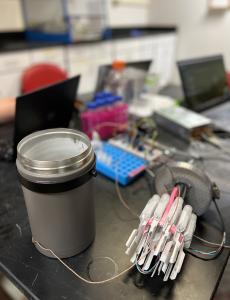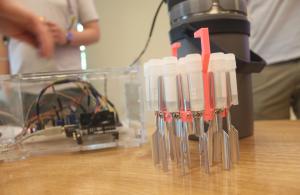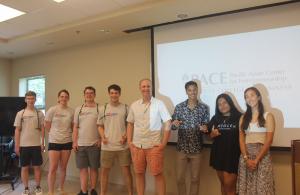Freezing, spawning, saving coral through UH, Minnesota partnership
University of Hawaiʻi at MānoaStudent scientists successfully collected coral egg and sperm bundles to test on a redesigned cryo freezing device at the University of Hawaiʻi at Mānoa’s Hawaiʻi Institute of Marine Biology (HIMB) on Moku o Loʻe (Coconut Island) in the evening of June 19, marking a crucial step in saving the species threatened by climate change and pollution.
Montipora capitata, a type of coral commonly found in Hawaiʻi, is known to reproduce on nights surrounding the new moon in late May to July. During these rare spawning events, colonies release thousands of egg-sperm bundles.
At 8:45 p.m. on June 19, under the glow of red light headlamps that are less invasive to the coral, scientists and students at UH Mānoa and the University of Minnesota waited patiently for egg-sperm bundles that resemble tiny styrofoam beads to rise to the surface of the water. Once at the surface, the bundles were carefully extracted and placed into vials. The work during the evening produced thousands of bundles for collection and testing.
Coral sperm will be stored using cryopreservation, which is a process that freezes to preserve them. By freezing coral sperm, scientists are able to bank samples until they can be transported around the world and transferred to coral eggs of varying species of coral. Having diverse coral reefs provides a more flourishing ecosystem that supports more plants and wildlife.
UH Mānoa biology and business student Jia Cashon said, “We were very lucky to get to experience the magic of it all with the Hagedorn Lab (at HIMB) and to see how it contributes to our understanding of coral ecology and conservation efforts.”
Successful partnership and cross-disciplinary collaboration
Both UH Mānoa and University of Minnesota students worked for several months leading up to the successful June event. Minnesota mechanical engineering students have been improving and redesigning a portable cryofreezer since January. Improvements to the device include increased capacity to freeze more samples, and utilization of a microcontroller computer for better control over freezing and thawing rates and temperatures. Using the redesigned cryofreezer, the team was able to produce healthy and viable post-thaw sperm at a higher rate than the previous version of the device.
The Pacific Asian Center for Entrepreneurship (PACE) in UH Mānoa’s Shidler College of Business identified a team of UH students who are passionate about ocean conservation efforts and tasked them to develop a market feasibility study and commercialization strategy for the freezing device.
The team includes Cashon, computer engineering major Sincere Bolling, marketing major Rzenseth Cabansag, entrepreneurship major Joshua McDade, and marine biology major Quentin Shores. This team of students has been working on market validation and customer identification for the device since January, and is currently completing its final weeks in the PACE Summer Startup Launchpad program. Guided by PACE Faculty Fellow Blake Nichols and mentors in the program, the team identified what could be a billion-dollar market for cryopreservation of not just coral sperm, but other biological organisms, and honed in on potential customers for the freezing device.
PACE Executive Director Sandra Fujiyama said, “When School of Ocean and Earth Science and Technology Associate Dean for Academic Affairs Judy Lemus proposed this project, I knew PACE needed to be involved. Students from varying fields of study can learn so much more from each other. I am grateful to Dr. Judy Lemus and Dr. Mary Hagedorn for seeing the value in looking ahead to the commercial potential of inventions and technologies. We hope to participate in more interdisciplinary projects like these that bring different disciplines and groups together, and give students unique, dynamic, real-world learning experiences.”
The collaboration was made possible with the support of Hagedorn, senior research scientist at HIMB, who offered lab space, lodging and scientists from her team to lead the sperm-egg bundle collection and testing.
“We wanted the UH and University of Minnesota students to be exposed to a remarkable natural event, and to think creatively about the many problems and opportunities in conservation and cryopreservation,” said Nikolas Zuchowicz, University of Minnesota PhD student and workshop organizer. “We anticipated that the design team and the entrepreneurship team would look at cryopreservation technology in a new way and bring fresh ideas into our community. They have done this, and we are delighted with their work. We look forward to planning the next steps to further improve freezing methods and to get our collective work out into the world.”

